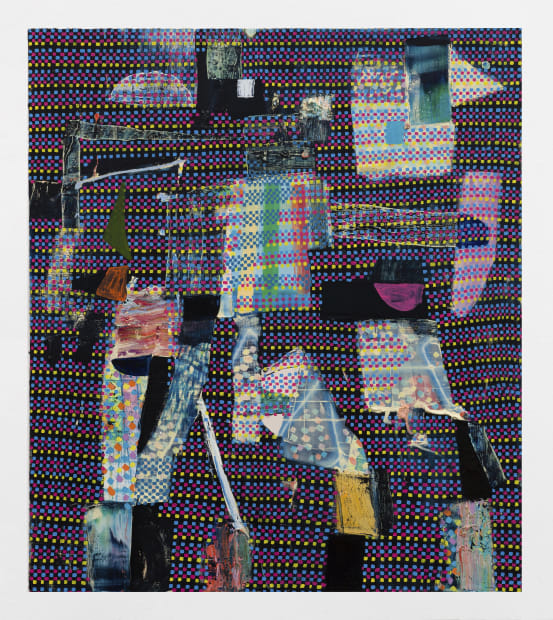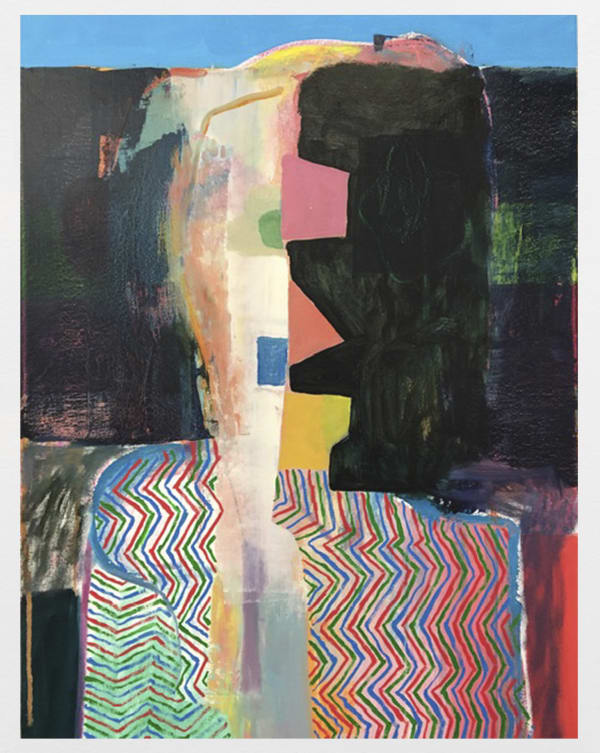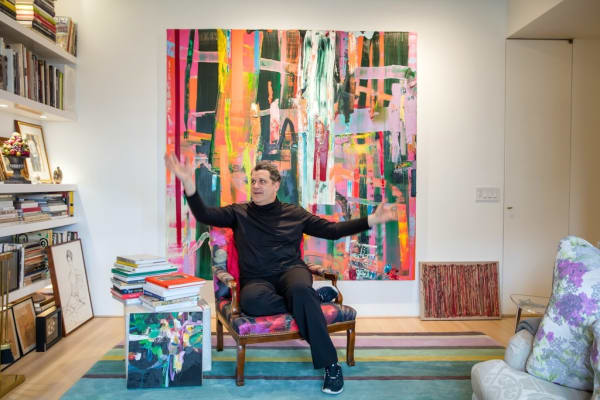-
Tomory Dodge
In the Studio -

-

-

-

-

-
To hear Tomory Dodge discuss his studio practice and new works, click here.
-
Works by Tomory Dodge
(Click on images to inquire)-

Tomory Dodge
Spring, 2020
Oil on canvas
72 x 60 in
182.9 x 152.4 cm
-

Tomory Dodge
Trees at Night, 2020
Oil on canvas
13 x 12 in
33 x 30.5 cm -

Tomory Dodge
Portrait, 2020
Oil on canvas
24 x 18 in
61 x 45.7 cm -

Tomory Dodge
Constellation, 2017
Collage, acrylic on paper
12 x 16 in
30.5 x 40.6 cm
-

Tomory Dodge
Deep Space Utility (Weak Signal), 2018Oil on canvas
48 x 40 in
121.9 x 101.6 cm
-

Tomory Dodge
Figure, 2019
Collage, acrylic on paper
12 x 9 in
30.5 x 22.9 cm
-
-
Press Release
Tomory Dodge is one of the most important painters working in Los Angeles today. Over the course of his career, Dodge has become known for dynamic paintings that explore the representation and mechanics of picture-making. He writes, “I have often talked about paintings being inherently contradictory things. They are objects that are spaces, walls that are windows. They are the intersection of object and image. Painting maintains a physical anchor at a time when the image generally is becoming more and more ethereal—everywhere and nowhere at the same time.”
Painting’s power to represent images and events means that we often forget the fact that paintings themselves are a matrix of applied material signs. The vision of the painter and the subjects that they depict are figured through brushstroke, color and texture. Dodge comments, “Paradoxically, similar to analytic cubism perhaps, the attempt to understand something in its totality often results in partially obscuring it.” Within Dodge’s large oil-on-canvas paintings, many smaller “paintings” seem to jostle together, making room for themselves within the greater composition. The artist’s practice is both additive and reductive. He paints over older moments and scraps away, finding the painting within the painting, to reach the final form of the work.
In addition to his skill as a painter, Tomory Dodge is also a skilled musician, with a particular interest in a form of electronic music called “modular synthesis.” This is a type of music-making involving synthesizers in which any output from any stage in the signal past can be used as the starting point for new compositions. Dodge’s music practice finds a parallel in his art practice, as his paintings function in a similar fashion. They grow upon themselves, as layers are recovered after being uncovered, and new layers are built. “I do see painting as a kind of recording and recording as a kind of painting.” he says. Dodge’s work succinctly addresses the looping nature of human experience and the problematics of modern society, its representations, and the role of painting in exploring them.
Tomory Dodge (b. 1974, Denver, CO) received his BFA from Rhode Island School of Design (Providence, RI) in 1998 and his MFA from California Institute of the Arts (Valencia, CA) in 2004. In the winter of 2020, Dodge will be the subject of a solo exhibition at Ceysson et Bénétière (Paris, France). Recent solo and group exhibitions include Philip Martin Gallery (Los Angeles, CA); LUX Art Institute (Encinitas, CA); "Stranger Than Paradise," Rhode Island School of Design Museum (Providence, RI); "Grafforists," Torrance Art Museum (Torrance, CA); "Nowism," Pizzuti Collection (Columbus, OH); "An Appetite For Painting," National Museum (Oslo, Norway); "Pouring It On," Herter Art Gallery, University of Massachusetts (Amherst, MA); "Tomory Dodge and Denise Thomasos: Directions to a Dirty Place," Southeastern Center for Contemporary Art (Winston-Salem, NC); "Future Tense: Reshaping the Landscape," Neuberger Museum of Art (Purchase, NY); "American Soil," Nerman Museum of Contemporary Art (Overland Park, KS); "Sheldon Survey," Sheldon Memorial Gallery, University of Nebraska (Lincoln, NE). His work is in the collections of such museums as Los Angeles County Museum of Art (Los Angeles, CA); Orange County Museum of Art (Newport Beach, CA); San Francisco Museum of Modern Art, (San Francisco, CA); Berkeley Art Museum and Pacific Film Archive (Berkeley, CA); Henry Art Gallery (Seattle, WA); Dallas Museum of Art (Dallas, TX); Nerman Museum of Contemporary Art (Overland Park, KS); Orlando Museum of Art (Orlando, FL); Knoxville Museum of Art (Knoxville, TN); Weatherspoon Art Museum (Greensboro, NC); Smithsonian American Art Museum (Washington, DC); RISD Museum, Rhode Island School of Design (Providence, RI); Yale University Art Gallery (New Haven, CT); and Whitney Museum of American Art (New York, NY). Dodge's work is the subject of several monographic catalogs and has been discussed in such publications as “Artforum,” “Flash Art,” “Modern Painters,” “Art Review,” “Los Angeles Times,” and “The New York Times.” Dodge lives and works in Los Angeles, CA. -
More on Tomory Dodge
-

Review: Striped, dotted, zigzagged. The mind-scrambling painting of Tomory Dodge
Pagel, David. Los Angeles Times October 10, 2019When the suburbs were invented, real estate was more plentiful than it is now and neighborhoods spread out. That kind of sprawl represented a new way of organizing homes and... -

Isaac Mizrahi, on Collecting Art in Search of the Me Factor
Kourlas, Gia. The New York Times January 12, 2017A brisk tour of the art in Isaac Mizrahi’s Greenwich Village apartment is intimate — like an introduction to this fashion designer’s 20 closest friends. Lining his walls are works... -

Future Animals by Tomory Dodge
April 10, 2018Released April 10, 2018. Limited edition of 100 copies with covers hand printed by Tomory Dodge. Due to the hand printing, no two copies are identical and covers may contain...
-
-
Inquire about works by Tomory Dodge
Tomory Dodge: In the Studio
Past viewing_room













